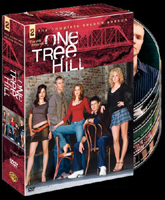 BUY IT AT AMAZON: CLICK HERE!
BUY IT AT AMAZON: CLICK HERE!
STUDIO: Warner Home Video
MSRP: $59.98
RATED: Unrated
RUNNING TIME: 993 Minutes
SPECIAL FEATURES:
• Diaries from the Set featurettes
• The Music of One Tree Hill featurette
• Change is Good featurette
• Selected Commentaries
• Unaired Scenes
"Pop"
isn’t a derisive word; it’s descriptive. It implies something suitable for
consumption by a broad demographic, something inoffensive and familiar. Pop
music is built on repetition of themes and structures. Pop television follows a
similar pattern, revisiting old plots with new characters in a sort of
"Here comes the new show, same as the old show" mode.
One Tree Hill is firmly couched in both the pop
television and pop music traditions. The episodes are filled with pop music,
given titles that are similar or identical to current pop songs, and follow the
character types made common by years of popular entertainment. The show blazes
no new trails, but, to its credit, it remains captivating enough not to dig its
rut any deeper.
The Show
The
fictional city of Tree Hill (which is rumored to have been named after the U2
album "The Joshua Tree") is home to the show’s wide cast of fit-ins
(or, the opposite of "misfits") and their families. Much like Fox’s The
OC, One Tree Hill doesn’t focus exclusively on the teenagers, but
also stretches out to include dedicated subplots for their parents and other
adults. Central to the web of characters is the Scott family: Dan (Paul
Johansson), Nathan (James Lafferty), Lucas (Chad Michael Murray, of recent House
of Wax fame), and their unimportant mother. Nathan grew up with his
father and mother in Tree Hill, but Lucas, an illegitimate child, doesn’t
arrive on the scene until high school. In the first season, as I understand,
the boys feel out a series of uneasy truces as they make an effort to be
brothers; in the second season, their spheres of influence begin to expand in
different directions and their interactions are minimal.
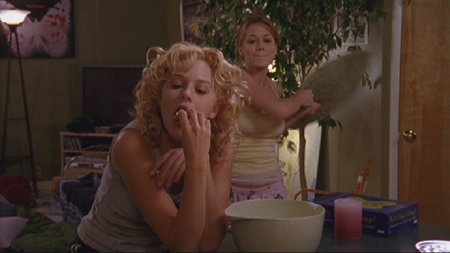
My friends, I give you a panty-clad pillow fight.
In fine
soap opera form, there is never a single arching plot to follow, but rather a
series of short arcs that extend from the characters. Inasmuch as there is an
aim to this second season, it follows from Dan Scott, a car salesman, and his
machinations to ruin the lives of his family. Dan is a jealous man, and the
writers come dangerously close to making him nothing more than an evil man.
It’s his Bond-villain plots that drive the majority of this season’s drama: he
conspires to destroy his son Nathan’s new marriage to his sweetheart, Haley
(Bethany Joy Lenz); he drives wedges between Lucas and his mother; he hires a
woman to fake a relationship with his brother, Keith, just to break Keith’s
heart.
Dan’s
evil-genius mentality is the bridge between the portions of the show aimed more
toward adults and those aimed at teenage viewers. There’s not a huge gap in
maturity between the two sides; instead, to keep the structure somewhat
separate, the respective focuses are on different emotions. For the teens, it’s
love; for the adults, it’s revenge.
The teen
side of things gets the more believable and engrossing stories. The show deals
with the early marriage of Nathan Scott and his girlfriend, Haley, both only
high school juniors. What could easily have been a wishy-washy subplot that
romanticized the concept of marriage devolves quickly into a set of far-fetched
but plausible choices that drive the characters apart and destroys their
relationship. Other storylines for the teens include one girl, Peyton (Hilarie
Burton), mixing love and outrage in a relationship with a young single father,
and another of the leads, Brooke (Sophia Bush), taking a series of respectable
steps to prove that she is not a dumb slut.
The
difference in effectiveness between the sections focused on the adults and
those focused on the teens is a direct result of the melodrama. Where the
adults feel as though they’re taking part in a revamp of a medieval revenge
drama (and Dan’s theatrics get eye-rollingly bad at times), the teens convey a
greater sense of realism, and a refreshing lack of cheap emotional tricks to
hook the audience.
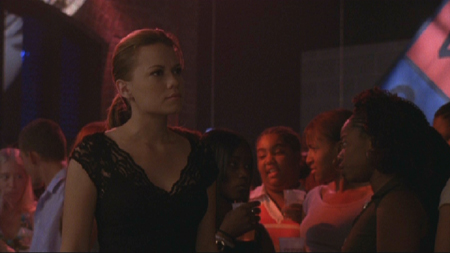
Every thought I have is cruel.
The plot-level
elements are satisfying, but at the level of the dialogue things begin the
break down. The series’ writers never have a good grip either of the rhythms of
teenage slang (including painful forays into ebonics) nor the erudite beats of
businessmen. In each episode, the performances fluctuate wildly depending on
the particular lines being read. This unevenness quickly becomes distracting.
The
different actors handle the challenge to varying degrees of success (Moira
Kelly, as Lucas’ mother Karen, is the ablest actor in the crew), and the show
pulls off a true ensemble of characters, with no one being given dominant
screentime. As a result, any standouts in the "flat line-reading"
department don’t monopolize the attention. Most of the characters have
compelling, individual aims on their characters; there is one notable
exception, however — that’s Chad Michael Murray’s Lucas. His aimlessness is
written into the show, and resolved in the season finale, but it feels more
like retconning than something deliberate. Many of the arcs go without a
conclusion, and the buildup is solid enough to invite the viewing of the
following season, which will premier Sep. 28 on The WB.
Without
any real depth to it, One Tree Hill manages to involve the
viewer in its characters and their interactions. I’d liken it to candy, except
that there’s much more bitterness in the stories than there is sweetness. It’s
more like a pop song — it oscillates between the verses and choruses with
predictable regularity, its dominant melodies are appealing while they’re
playing; they stick in your head for a few minutes, and then are displaced by
the next tune to reach your ears.
6.5 out of 10
The Look
1.65:1 widescreen
aspect ratio. The transfer from the original video is clean and colorful. The
details are all nicely captured. As an example, Peyton has a number of small
one-panel cartoons pasted about her room, and as your eye travels around during
the occasional tracking shots, the black-on-white lines form very distinct impressions,
and the cartoons begin to feel familiar before long.
showrunners here did an overall decent job of filling the frames. If your eye
wanders from the speaking character, as a possible result of banal dialogue, the
sets seem very much alive, dressed creatively and with care (and possibly
offensive for those unnerved by the styles of white middle-class
7 out of 10
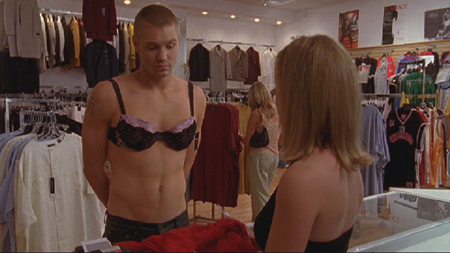
"You don’t matter. You don’t matter, except that you make an impression."
The Noise
Dolby
Digital 2.0 surround, which features an English fucktonne of pop music. The
producers let their influences show on their proverbial sleeves. Some of the
episodes are a bit like listening to local radio at mid-day. Nearly every
episode ends with a montage set to a current familiar tune.
The score
is somewhat dwarfed by all these noisy hipsters, but Mark Snow (The
X-Files) turns in an unobtrusive and supporting set of cues. The
dialogue trades positions with the licensed soundtrack in the mix. From time to
time, it feels as though the producers wanted to get the most they could out of
a particular song, because the dialogue gets drowned out. That’s all right. We
can infer the drama, anyway.
The pop
music is an important facet of the show, however, and its being a frequent
focus of the episodes fits cleanly beside the melodrama.
Avoid
like hell if you’re not fond of pop music, however.
7 out of 10
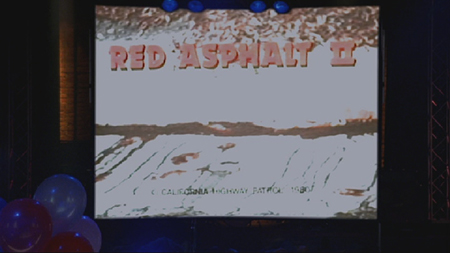
Most effective "movie-within-a-movie" on record.
The Goodies
There are
a decent number of bonuses spread across the six discs. Many of the episodes
have unaired scenes; none of them are important to the progression of the
season’s arc, but there are a few nice character moments that didn’t make it to
the screen.
A
featurette called "The Music of One Tree Hill" explores the pop music
fascination of the show’s producers, as filtered through the actors and
occasional musical guests (such as Michelle Branch.) This is a decent little
feature, if for no other reason than because it bandies about the names of the
some of the tunes used in the season. A credit list of all included songs is
sorely lacking.
A few on-set camcorder hijinks are captured in
the "Diaries from the Set" featurettes. These behind-the-scenes
things are rarely interesting, but their inclusion is a nice touch, especially
for those looking to deepen their connection to the characters through
observation of the actors. Biographical criticism was never my strong suit,
though, so I thought this was a throwaway feature.
The third
and final featurette is called "Change is Good" and it is basically a
rogue’s gallery of the new faces added into the show since its first season.
Having just watched the season, it wasn’t very useful to me as a viewer, nor
would it be to anyone. Call this is padding piece.
The last
bonus features of note are the three episodes featuring commentary tracks from
the show’s creator, Mark Schwann. These selected commentaries are aimed at
someone other than the casual viewer, as Schwann is evidently far more obsessed
with the show and its characters than was this reviewer. It’s a nice bonus for
the fans of the show, I imagine, though it’s unfortunate the commentaries don’t
appear on more episodes.
7.3 out of 10
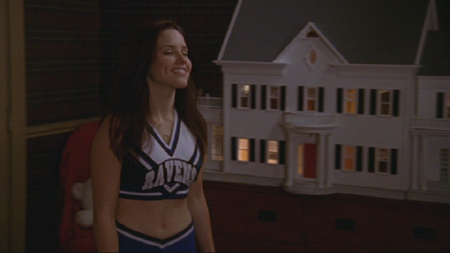
She has a two-car vagina.
The Artwork
Obviously,
the male viewers of this show are in it for the legs. Hilarie Burton and Sophia
Bush look stunning to a fetishist, merely damn hot to the rest of us. Short
skirts are good, but it’s just an element in a cast photo. The show doesn’t
have an immediately recognizable logo to set it apart, so there’s nothing to
distinguish this set from any other here-and-gone boxed set. Also, the same
photograph is repeated throughout all the packaging, so there’s no variety.
Basically,
you need to already be familiar with these faces (and legs) to have your
interest piqued by the packaging.
5 out of 10
Overall 6.9 out of 10